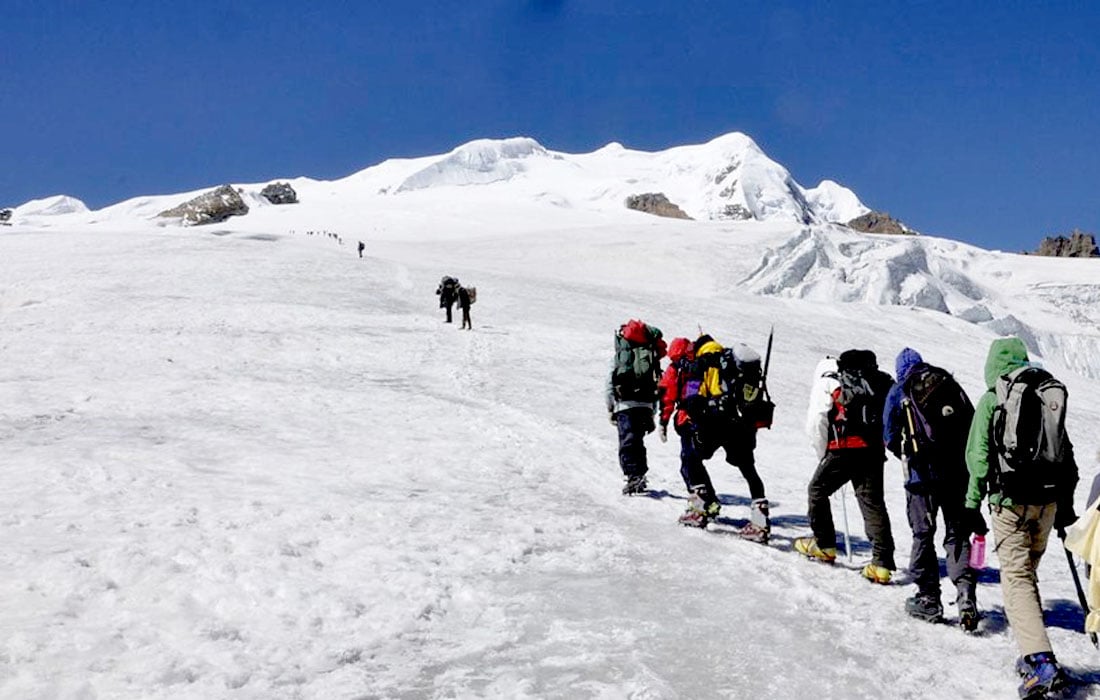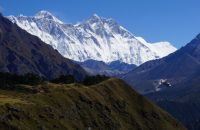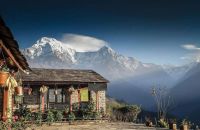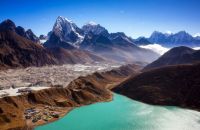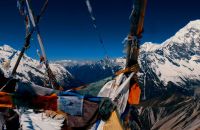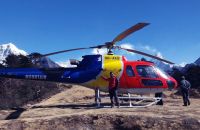Talk with our local travel specialist who can help organize your trip.
Best Time to Climb Mera Peak in Nepal
Mera Peak is the top pick for many climbers choosing a 6000-meter Himalayan ascent. The peak, which lies in the mountainous Everest Region of Nepal, is a huge draw for budding climbers seeking a non-technical mountain. Climbers choose either spring or autumn to make their trip as these two seasons are generally regarded as the best time to climb Mera Peak.
Where is Mera Peak?
Mera Peak is located in eastern Nepal's Hinku Valley, inside the magnificent Makalu Barun National Park. Its exact geographical location is 27.70670°N latitude and 86.86920°E longitude.
Soaring to a height of 6476 meters, Mera Peak is Nepal's highest trekking peak.
The three summits of Mera Peak – North, Central, and South
Mera Peak has three summits – Central, North, and South. Most expedition groups choose the Mera Central for their summit push as it has the most straightforward route. Jimmy Roberts and Sen Tenzing were the first two climbers to reach the summit of Mera Peak (Central) in 1953.
How to reach Mera Peak?

There are two trekking routes leading to Khare at the base of Mera Peak. The trail that starts from Lukla and goes past Chutanga and the Zatarwa La pass is the shortest. It takes only five days to reach the base of Mera Peak, but it is challenging. There are long days of walking on steep and rocky terrain and several crossings over high mountain passes.
The longer and slightly easier route takes you via Paiya and Panggom. It will take around seven days to trek from Lukla to Mera Peak Base Camp if you take this route.
Some climbers choose to take the classic trail from Jiri or Salleri instead of flying straight to Lukla. One can also fly to Phaplu and head to Khare via Pangkongma and Nanjing Dingma.
Mera Peak Climbing Route
The ascent to Mera Peak is basically non-technical. The first part of the climb involves climbing through gravel and rocks. It's a steep hike up to Mera High Camp via Mera La glacier. You spend one night at the High Camp. Your summit push starts early the next day at around 1 or 2 AM.
The route follows an easy incline of thirty or forty degrees up the mountain. The last leg of the climb leading to the summit is the toughest. It is a steep ascent needing fixed ropes and jumars to climb the dome of Mera Peak Central's summit.
From the summit, you get fantastic views of five of the tallest mountains in the world – Mount Everest, Lhotse, Makalu, Kanchenjunga, and Cho Oyu. Besides these giants, you can view several 6000 and 7000-meter peaks stretching as far as the eyes can see.
Where to travel next?
Get help from our travel specialists for holiday ideas that matches your interests.
Best Time to Climb Mera Peak

The best time to climb Mera Peak are spring (March, April, and May) and autumn (September, October, and November). Weather conditions during these seasons remain stable and favorable for climbing Mera Peak.
What to expect in spring (March, April, and May)?
If you plan a spring ascent to Mera Peak, you can expect stable weather with an occasional spring shower. It gets warm during the daytime, but nights are usually cold.
Since spring is peak season, the trail may be crowded, and it will get difficult to obtain flight tickets and accommodation if you don't pre-book your trip.
What to expect in autumn (September, October, and November)?
Most climbers choose October to make their summit bid to Mera Peak. Autumn is by far the most popular season for Mera Peak climbing. It is drier than other seasons, and the weather remains stable. The skies remain cloudless, letting one enjoy stunning views of the mountains.
However, you might have to share the trail with many other tourists and face some hassles getting accommodation if not booked in advance.
What to expect in the summer or monsoon season (June, July, and August)?
Climbers and trekkers choose to stay away from the trail during summer or monsoon season as the trail gets slippery and muddy. There is heavy rainfall, and the path gets choked by mud and seasonal streams. Fog and mist roll in throughout the day, obstructing the mountain views.
What to expect in winter (December, January, and February)?
During winter, extreme cold and snow make it almost impossible to get to Mera Peak. The days get shorter, and it starts getting dark early, making it hazardous to spend long hours on the trail. Walking on snow and ice also makes a winter trip to Mera Peak difficult.
Permits needed for Mera Peak Climbing

You need to obtain a Mera Peak Climbing permit from the Nepal Mountaineering Association. For the trek, you need to have entrance tickets to the Makalu Barun National Park and Khumbu Pasang Lhamu Rural Municipality.
Mera Peak Climbing Itinerary
There are generally three itineraries you can follow to climb Mera Peak. The itinerary that follows the Pangom, Paiya, Ningsow, and Chetra Khola route (Mera Peak Climbing) takes around 18 or 19 days to complete.
The shortest and the most challenging itinerary takes you to Mera Peak via Chutanga and Kothe. If you follow this Mera Peak Climbing Itinerary, you can complete your trip in 12 or 14 days.
The third itinerary involves taking a flight to Phaplu instead of Lukla. You walk via Thaksindo, Cholem Kharka, and Paanch Pokhari to reach the mountain's base. The duration of this itinerary is 19 or 20 days.
You can club Mera Peak climb with Amphu Labtsa and EBC Trek for a more thrilling adventure. Climbers on a Mount Everest expedition sometimes scale both Mera Peak and Island Peak to acclimatize.
Can you climb Mera Peak?
Yes, if you have basic mountaineering skills and have done your share of high-altitude treks. No technical climbing is involved while scaling Mera Peak, which makes it a perfect choice for novice climbers.
The only concern is the risk of AMS (acute mountain sickness), cold and high wind. More than climbing skills, one needs stamina and high endurance level to reach the top of this mountain.
Where to travel next?
Get help from our travel specialists for holiday ideas that matches your interests.
Mera Peak Climbing Grade and Difficulty

The difficulty of Mera Peak is graded PD (peu difficile or a bit difficult) on the Alpine Grade scale. You will have to climb at high altitudes, cross glaciers, and walk on ice and snow. Only the final section of the climb is technical. You will be using fixed ropes and jumars to tackle the steep ascent to the top. You only spend one night at Mera Peak (High Camp) while making your way to the top.
Mera Peak Climbing Gear and Equipment
The success of any serious peak climbing expedition depends on the planning and the quality of gear and equipment. At high altitudes, the conditions are brutal and unforgiving. In order to face the harsh mountain environment (chill, wind, snow, and precipitation), you need to have the appropriate gear.
We have posted a detailed blog on what to pack for a Peak Climbing adventure. Do check it out.
What makes Mera Peak special?
Apart from being Nepal's tallest trekking peak offering a non-technical ascent, the location of Mera Peak makes it one of the best trekking destinations to experience high-altitude Himalayan landscape. The trail leading to Mera Peak goes through the sparsely inhabited Hinku and Hongku Valleys.
Walking through sub-alpine and alpine landscapes, you can explore one of Nepal's least explored trails. You enter the pristine Makalu Barun National Park, which is home to endangered wildlife and vegetation. Here you will come across 25 of the 30 rhododendron varieties found in Nepal.
With no major settlements en route, you will be walking in the wild, staying overnight at teahouses built near yak kharkas or yak herders' camps.
In conclusion
Mera Peak offers the best opportunity for climbers who want to transition to 7000 or 8000-meter mountain climbing. The conditions while ascending on the mountain prepares you for your next ascent, which could be more complex and challenging.
For experienced climbers, this high altitude climbing is just right to serve as an acclimatization climb.
It is vital to choose the best time to climb Mera Peak before making plans for your trip. Autumn and spring are by far the most favorable seasons for this climbing adventure. Planning your trip during these seasons will surely guarantee a successful summit bid.
- Written by: Naba Raj Amgai
Updated: Jun, 7, 2022

